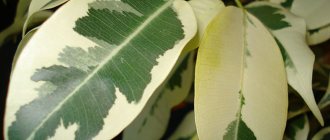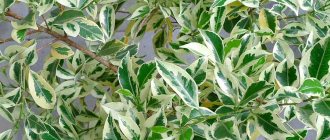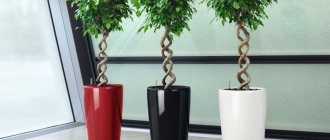Plants » Flowers
0
2322
Article rating
Kira Stoletova
Benjamin's ficuses are especially popular among gardeners. One of them - ficus Natasha (ficus natasja benjamina) - is an evergreen plant from the mulberry family, which is increasingly found on the windowsills of residential apartments, offices and other institutions. Ficus Natasha is extremely popular due to its unpretentiousness and beauty. There is something about this flower that makes a room feel cozy.
Ficus Benjamina Natasha
Many signs say that in a house where a ficus is located, people quarrel less, problems are solved, and ficuses also help couples with their energy to have a long-awaited child.
Ficuses are aliens from Asian countries, the Australian subtropics, China and the islands of Java and Ceylon; in nature they reach gigantic sizes: up to 10 m in length. Domesticated ficus trees are much more modest in size. For example, ficus Natasha is only 40 cm in height. The Natasha variety is formed into a compact bush, the branches of which can be connected in several pieces to make a neat bonsai-type plant.
Description of the plant
Many gardeners plant such a ficus specifically for the art of bonsai, so the small growth of the flower will be a plus. The color of this variety is varied: from dark green to green with light splashes, leaves are 3 and 1.5 cm in size, slightly shiny. Ficuses of this kind do not require too much painstaking care, but in order to achieve a beautiful crown of the bush, you need to follow the care recommendations: water the plant on time and correctly, feed it.
Caring for such a flower at home is not difficult, and if all the rules are followed, even a beginner can grow such a plant. Ficus benjamina variety Natasha is suitable for making various compositions along with other flowers. Before purchasing, you need to learn how to care for the ficus variety Natasha so that the plant enjoys active growth. You can see what ficus Natasha looks like in a photo or video.
Lighting and temperature for ficus Natasha
Ficus Natasha does not really like to move from place to place - it is better to determine a permanent place of residence for him in advance. Such a place should not be located near heating systems or in a draft; the temperature should not fall below 13°C or rise above 28°C. If the ficus doesn’t like the conditions, it can easily shed its leaves. It is best to place the ficus near the window.
If the ficus suddenly drops its leaves, there is no need to worry: the plant will adapt and grow new foliage if you take care of it. It is very useful to shake the leaves and spray with settled water at room temperature - this will help to form a lush crown. Ficus even in miniature looks like a real tree.
Watering the plants and fertilizing
It is better to water Ficus Benjamin Natasha in several stages so that the soil in the pot gets wet evenly. The water must be left standing for at least a day, at room temperature. The flower does not tolerate dry soil, but excessive watering is contraindicated. After watering, do not forget to empty the water from the pan: if left, the roots may rot. If the leaves turn yellow and fall off after purchase, this may be a reaction to improper watering or a change in regime. In this case, you need to adapt the ficus at home, and also adjust the watering regime.
If the Natasha variety sheds its leaves and the problem is not watering, the lighting may be incorrect. You can learn more about caring for ficus Natasha in the photo or video.
How can you feed ficus? The plant's winter season is a dormant period, so there is no need to fertilize it at this time. But the rest of the time, the ficus needs to be fed monthly. When choosing a mineral fertilizer, you must carefully read the instructions; the dosage must be followed exactly, otherwise the flower may get sick. Nitrogen fertilizers contribute to the growth of a lush crown. It is better to alternate mineral and organic fertilizers rather than apply them together; excess fertilizers can lead to fungal diseases.
Ficus benjamina transplant
It is not recommended to replant the flower immediately after purchase. After purchasing a ficus Benj, it will take about 2 weeks for it to adapt at home to a new place. Therefore, the ficus Natasha transplant should be done no earlier than after 2 weeks, or even a month. Transplantation is carried out from the beginning of April to the end of August. Young plants need to be replanted every year, and adults - once every 3-4 years.
A sure sign that the time has come for replanting is more frequent drying out of the soil, indicating that the roots are cramped in the pot. When starting to replant, you need to take a new pot 3-4 cm larger than the previous one in width and height. You should definitely put a good drainage layer on the bottom, and pour a special mixture for ficus with humus, sand and peat on top. Next, you need to carefully remove the flower from the old pot along with the earthen ball, without damaging the roots, and replant it in a new place. Along the edges of the pot, between the walls of the container, you need to add a little soil and carefully compact it.
Features of care
The plant is considered unpretentious, but may lose its decorative effect if not properly cared for.
- Lighting. Light-loving plant. Neutral to direct sunlight. In the shade, the leaves lose their gloss and the trunk becomes bent. The optimal location is southwest, southeast. The ficus is systematically rotated to uniformly shape the crown.
- Temperature. Loves warmth. Suitable temperature for growing is 25-30°C. In hot weather, spray daily.
- Humidity. Reacts gratefully to the creation of high humidity. In addition to spraying, the plant is bathed in a warm shower. In hot weather, water procedures are carried out more often. In winter, the batteries are covered with a wet cloth. The installation of special air humidifiers is encouraged.
- Watering. Watering is regular, moderate, using warm, settled water. The need for regular watering is determined by the degree of drying out of the soil. In summer only the top layer should dry out, in winter a little deeper. Complete drying is not allowed.
- The soil. Use special soils for ficuses. The mixture is prepared independently from turf, sand, bottom peat, and leaf soil. A small amount of perlite is added to loosen, and soaked hydrogel granules are added to maintain moisture.
- Transfer. Replant in the spring as the root system grows. Young trees - annually, older specimens - once every 2 years. The pot is filled one third with a drainage mixture - coarse sand, pebbles, fine expanded clay.
- Feeding. Fertilizers are applied in moderation in spring and summer. Use mineral complexes for ficuses. It is allowed to apply organic fertilizers in low concentrations.
Advice! Ficus responds gratefully to frequent spraying. It is recommended to do them twice a day. The crown of the plant is shaken from time to time. This promotes uniform distribution of air throughout the entire volume of the crown, making it lush.
Plant propagation
Ficus Natasha can be propagated in the spring. It is best to propagate from cuttings that have 3-4 buds. You can root it in water or plant it in the soil right away, but you need to create a greenhouse effect. You can use a special means for the formation of roots such as “Kornevin”. To do this, the cuttings should be “powdered” with a composition for the formation of roots or placed in a solution (if the instructions for the preparation say so) and planted in moist nutrient soil.
While the cutting is forming roots, it should be covered with a transparent film on top. The plant must be in this greenhouse until roots form. We must not forget to maintain moisture without flooding the soil. As soon as the first roots appear, the ficus can be planted in a permanent pot.
Bonsai creation
In order to form a bonsai, you do not need to know how to trim a ficus, because in this case its own separate technology is used.
Most often, to create the presented form, they take ficus Viandi, although you can take any other one.
The whole process begins with the cuttings being grown in wide but low flowerpots, which are filled with fairly “poor” soil. This is necessary so that the ficus does not grow quickly. The roots are pruned several times a year.
As for the branches and trunk, they are wrapped with thick wire in order to bend it the way you want. This will create the desired shape for the plant. A beautiful mini-tree is obtained in 3-4 years.
Ficus pruning
Pruning is important for the formation of the correct crown of the tree. You can also use it to restore a dried flower at home and get active growth. If this is not done, the branches will stretch in length and weaken, and this will greatly affect the health and appearance of the plant. Pruning is carried out in February, as soon as the flower begins to “wake up” and the first rudiments of leaves appear. Cut off all long and weak branches. Ficus benjamina is a fast-growing plant, so pruning should be done in the next year after purchase.
It is best to prune young shoots. The longer the branch, the shorter it needs to be cut. There is no need to be afraid to trim the tops: such pruning will only make the bush more luxuriant and lateral buds will form. The cut is made above the bud using pruning shears or garden shears, on thick shoots at an angle, and on thin shoots - straight. If the branches of the bush are damaged by pests, they must also be removed. The cut must be treated with a garden varnish to avoid ficus diseases. If you get milky sap on your hands when pruning, be sure to wash it off with soap and water.
Pests and diseases
Most often, ficus plants suffer from leaf spot and root rot. These types of plants periodically turn yellow and shed their leaves. This is most likely due to an uncomfortable environment. The temperature may be too high or, conversely, low. This tropical plant needs high air humidity, so it is better to install an air humidifier next to the ficus or, in the hot season, constantly raise the humidity by spraying the bush.
Overmoistening the soil does not benefit the flower; this can cause the ficus to develop root rot. This disease should be treated only by pruning damaged roots and special antifungal drugs. If the fungus has covered the entire flower, the plant needs to be replanted. Ficus plants also need to be fed in moderation; too much fertilizer can lead to fungal diseases.
Common ficus pests
- Spider mite. Ficuses are most often damaged by it. If whitish spots on the leaves or thin cobwebs become noticeable, the plant is most likely infected. Affected leaves fall off after spider mite attacks. After identifying the problem, you must immediately begin treating the plant with a special preparation for spider mites. Excessive dry air contributes to the appearance of such a pest. It is best to keep and grow a flower on the east or west side. During periods of solar activity, the ficus should be removed from direct exposure to the sun. In winter, to prevent the leaves from drying out, you need to maintain air humidity at at least 50-70%. You can place wet expanded clay or moss next to the flower.
- Shield. This pest feeds on the sap from the leaves and trunk, leaving special secretions, which in turn contribute to the appearance of sooty fungus. This is dangerous because the growth of the plant slows down, the leaves turn yellow and fall off. You can get rid of such a pest only by treating the flower with a medicinal composition, which can be purchased at a specialized store, and getting rid of damaged shoots. As a preventive measure against scale insects, it is recommended to inspect the flower daily for the presence of pests. If insects are found, they must be removed.
- Mealybug. This is a very small white insect that feeds on the sap of the plant. They get rid of it in the same way as they get rid of scale insects. Mealybugs appear due to improper care or feeding schedule. If a mealybug appears on a flower, the ficus may be oversaturated with nitrogen. When there is an excess of nitrogen in the leaves, metabolism is disrupted and they become vulnerable to attack by pests. When the air is dry, pests can attack the flower even more actively, so you should not place the ficus near heating devices. As a preventative measure, it is recommended to immediately remove dried leaves, as they serve as breeding grounds for insects. Periodically, you should give the flower a warm shower; it will wash away any possible insects.
Disease Prevention
Problems with ficus appear due to non-compliance with maintenance conditions. You can prevent these troubles if you know what is harmful to the flower. This may be dry air in the apartment, excessive watering or drying out of the earthen coma, drafts, lack of sunlight, frequent moving of the pot, stagnant water in the pan, too frequent fertilizing. To avoid problems with care, you should study the description of Ficus Benjamin and the rules of care.
Growing conditions
Benjamin Natasha is a variety that is distinguished by its demanding care. In order for the plant to develop properly and remain lush and green all year round, it is necessary to provide it with fertilizing and optimal levels of light and humidity.
Temperature
Tropical crops need warmth. The optimal temperature for keeping in room conditions is 25-30°C.
During the active growing season, you should not sharply turn the ficus pot relative to the light, otherwise the leaves will fall off. During the summer months, it is advisable to keep the plant on the balcony.
Humidity
For full development, ficus needs a sufficient amount of moisture.
During prolonged summer drought, regular spraying is useful; you can also periodically expose the crown to a shower with water.
Lighting
Ficus needs sunlight
Benjamin is light-loving. In the sun, the foliage takes on a rich color and glossy surface. Even direct lighting does not harm the sheet plates.
It is better to place the pot on a south-eastern or south-western window sill. It is advisable to gradually rotate the plant around its axis so that all parts of the crown receive a sufficient amount of light.
Do not place ficus in partial shade. This negatively affects the development of the tree, the trunk bends in the direction of the light source, and the leaves turn yellow.
Crown formation
You can make a real room decoration from a ficus if you know how to decorate the crown using proper pruning at home. Miniature ficuses are most often formed in the form of a ball, a multi-tiered trunk in the bonsai style, or in the form of some complex figures. It is best to start forming the crown of a tree while it is still young; older plants grow more slowly. Planned pruning for formation is carried out in early spring during the period when active growth begins. You can trim the ficus at another time if very elongated shoots appear; branches growing inside the bush, damaged and dry branches are also removed immediately. Ficuses are often “braided” with each other, connecting two, three or more plants into one to give a decorative look and make the crown more luxuriant.
If you have four young ficus trees that individually do not have very dense foliage and you want to combine them into one plant, you can try braiding them. To do this, you need to prepare a larger pot for them (all four root systems should fit in it), carefully remove the plants from the pots, remove a little of the old soil and fold them so that the trunks are as close to each other as possible. It is better to cut off any branches that get in the way. Then the plants are planted in a new container, adding soil along the edges and making sure to compact it.
It is necessary to compact it so that after watering the plant does not skew to the side or fall through in the pot. The trunks are wrapped with thread made of natural material or burlap ribbon, beautifully intertwined. Then the plant is pruned, forming a crown of the required shape. To give the plant a rounded shape, the side branches and tops are cut so that the crown is shaped like a ball. If pests suddenly appear on such a plant, you need to remember that between the trunks entwined with rope, they will multiply most of all, since optimal conditions for this have been created there. That is why we must not forget to carefully treat the rope itself with a medicinal preparation.
Tiered standard - what is it like?
A tiered trunk is a tree that has not one, but two crowns, separated by a void of several centimeters. Such a tree, depending on its height, may even have more than two, and sometimes three, tiers.
Usually it all starts with one crown of ficus Benjamin, and after that the tree is pruned so that the central shoot grows, which will be directed upward. Thanks to it, it will be possible to create a continuation of the trunk, and, consequently, another tier. Gardeners note that this process is long and quite painstaking.
As for the tiered trunk, created from one cutting, it is formed as follows:
- First, one cutting is selected, growing upward and forming a tall trunk.
- After the lower part of the trunk is formed (all shoots are removed), it will be necessary to divide the crown into three equal parts. The upper and lower parts will make up the crown, and the middle will act as a bare trunk.
- After division in the center, the side shoots are removed. As for the top of the trunk, it is pinched. Everything else is done according to the same scenario as in the case of creating a regular standard.
Experienced gardeners recommend planting two cuttings in a pot at the same time, the trunks of which will need to be fastened with wire. Over time, the bases will grow together at the bottom and separate at the top. Taking into account the different sizes of plants, it will be possible to create trunks that will look like tiers.
How to braid a ficus
To weave a ficus in the shape of a braid, you need 3 plants of the same size. This is important because a larger plant in a weave will over time choke out the growth of a smaller one. The ficus that was initially large will grow, but smaller ones may even stop growing.
Before weaving, you need to prepare the flower: cut off all the extra side branches almost to the top. You don’t have to throw away woody branches, but try to root them.
Next, you need to decide on the weaving: tight, so that eventually the trunks grow together and you get one plant with a trunk in the form of a braid, or so that they do not grow together and remain simply with trunks woven together. This formation and decision is necessary in order to determine how close to each other they are planned to be planted. To splice, you need to plant it very close.
Ficus benjamina should be removed from the pot and excess soil should be removed from the sides. Pour the mixture for decorative foliage flowers into the bottom of the prepared container. Place the ficus in the new pot as if inside as close as possible, if necessary. Weave the trunks, fastening them with thread or burlap ribbon. As the ropes grow, they can be removed. For braiding, it is better to take a flower with a height of 20-30 cm. Caring for a braid will be the same as for an ordinary plant.
Benefit
Ficus has long been called the “Family Flower”. It is believed that the family in which this plant appeared will have children in the near future.
This type of ficus has a wonderful property - it is able to purify the air from benzene and phenol, converting them into amino acids.
It makes an invaluable contribution to the indoor microclimate.
Important: the plant does not cause any harm; ficus benjamina is not poisonous.
Scientific name
Ficus Benjamina Natasha received its name in honor of the outstanding British botanist Benjamin Daydon Jackson, compiler of the famous reference book on floriculture. This tree is also a symbol of Bangkok.











